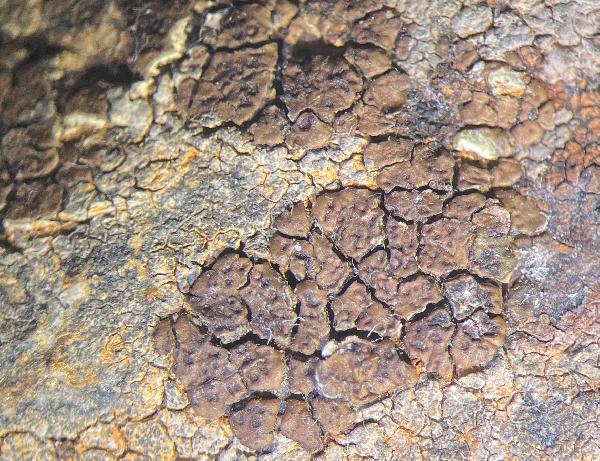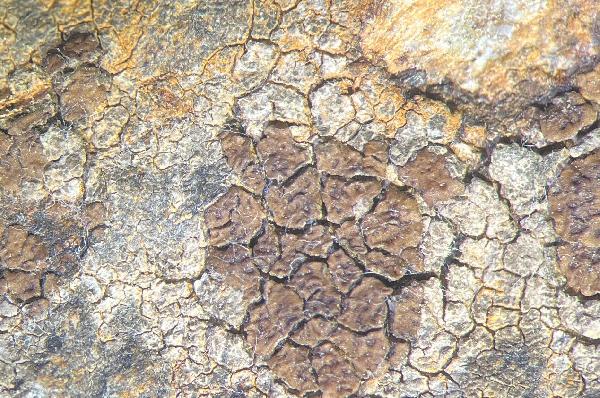Acarospora sphaerospora H. Magn.
Svensk Bot. Tidskr., 18: 338, 1924.
Synonyms: Acarospora firmiensis B. de Lesd.
Description: Thallus crustose, episubstratic, areolate-subsquamulose, the areoles sparse or gathered in small clusters, pale brown except at the brown-black margin, flat to slightly convex, 0.4-2.5 mm wide. Cortex 60-70 μm thick; algal layer of uniform thickness, continuous. Apothecia aspicilioid, at first punctiform, then with an expanded, round to elliptical or irregularly shaped, flat disc occupied by a single central umbo, with a poorly evident thalline margin. Epithecium brownish; hymenium colourless, 140-200 μm high; paraphyses abundantly branched and anastomosing, 1.5-2 μm thick at base; hypothecium colourless. Asci 100-200-spored, clavate, the apical dome K/I-. Ascospores 1-celled, hyaline, globose or subglobose, 3-5 x 3-4 μm. Photobiont chlorococcoid. Spot tests: cortex K- C+ pink, KC+ pink, P- (reactions often fleeting and observable only on thick sections under the microscope!). Chemistry: cortex with low quantities of gyrophoric acid.
Growth form: Crustose
Substrata: rocks
Photobiont: green algae other than Trentepohlia
Reproductive strategy: mainly sexual
paras Aspicilia when young
Commonnes-rarity: (info)
Alpine belt: absent
Subalpine belt: absent
Montane belt: very rare
Dry submediterranean belt: absent
Humid submediterranean belt: very rare
Padanian area: absent
pH of the substrata:
1 2 3 4 5
Solar irradiation:
1 2 3 4 5
Aridity:
1 2 3 4 5
Eutrophication:
1 2 3 4 5
Poleotolerance:
0 1 2 3
Altitudinal distribution:
1 2 3 4 5 6
Rarity
absent
extremely rare
very rare
rare
rather rare
rather common
common
very common
extremely common
Loading data...
Occurrence data
Predictive map

Juri Nascimbene - CC BY-SA 4.0
Herb. Nascimbene 7941 - Italy, Trentino-Alto Adige, Prov. Trento, Parco Naturale di Paneveggio-Pale di S.Martino, Cima Folga, 2382 m. Siliceous metamorphic rocks. 2021 Leg. et det. Juri Nascimbene
Growth form: Crustose
Substrata: rocks
Photobiont: green algae other than Trentepohlia
Reproductive strategy: mainly sexual
paras Aspicilia when young
Commonnes-rarity: (info)
Alpine belt: absent
Subalpine belt: absent
Montane belt: very rare
Dry submediterranean belt: absent
Humid submediterranean belt: very rare
Padanian area: absent
pH of the substrata:
| 1 | 2 | 3 | 4 | 5 |
Solar irradiation:
| 1 | 2 | 3 | 4 | 5 |
Aridity:
| 1 | 2 | 3 | 4 | 5 |
Eutrophication:
| 1 | 2 | 3 | 4 | 5 |
Poleotolerance:
| 0 | 1 | 2 | 3 |
Altitudinal distribution:
| 1 | 2 | 3 | 4 | 5 | 6 |
Rarity
absent
extremely rare
very rare
rare
rather rare
rather common
common
very common
extremely common
Loading data...
Occurrence data
Predictive map









